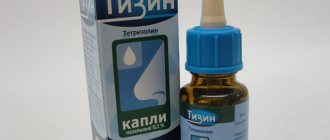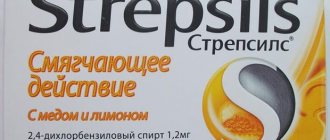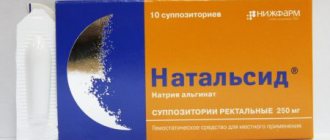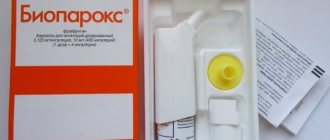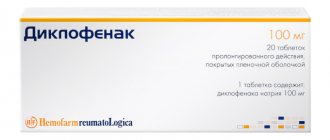Nowadays, treatment of muscles, joints and bones is not carried out without the use of painkillers and anti-inflammatory drugs. Among non-steroidal drugs that have an anti-inflammatory effect on the body, experts specifically highlight diclofenac. This medicine has different forms. Each can only be used taking into account the existing problem.
The drug in any form can effectively reduce temperature, relieve muscle and joint pain, and quickly clot blood. Such a wide range and not the largest number of contraindications allows you to take diclofenac during pregnancy. However, experts rarely prescribe it (except for gels and ointments) in the first and third trimesters.
Diclofenac during pregnancy
As already noted, diclofenac belongs to the group of non-steroidal drugs aimed at eliminating inflammation. It also has properties such as:
- antipyretic;
- pain reliever;
- antiplatelet;
- anti-inflammatory.
Since the medicine perfectly relieves pain, for example, joint pain, it is natural why patients choose it.
During pregnancy, a woman is most often bothered by pain in the lumbar region and pain in the pubic area. In their case, the drug should not be a painkiller that will replace other medications that are safer during pregnancy. It should be noted that there is quite a wide range of non-steroidal painkillers, and each of them has a particularly pronounced mechanism of action on the body.
Before we talk about whether diclofenac can be taken during pregnancy, we will determine in what forms it is produced. This significantly affects the intake for pregnant women. Pharmaceutical companies produce this medicine in the form of gels, ointments, suppositories, tablets and injections. During pregnancy, based on expert reviews, ointments, creams and gels can be used safely for the fetus and the expectant mother herself. The remaining forms of the medicine enter the bloodstream and in any case, one way or another, will affect the development of the unborn baby.
There are a number of indications for topical use during pregnancy. The main ones include:
- various forms of neuralgia, including intercostal, are observed with osteochondrosis, when the nerve ending is pinched;
- myalgia, which is characterized by pain in muscle tissue;
- the development of arthralgia - pain in the joint, which may be associated with the development of osteoarthritis, arthritis, and various injuries;
- receiving bruises and sprains as a result of the injury.
Taking the drug during pregnancy is associated with the intensity of pain. Most often it is applied no more than three to four times a day. Ointments and gels are applied with massaging movements until completely absorbed.
Systemic actions in a woman’s body during pregnancy suppress the increased ability of the uterus to contract. Thus, the body reduces the likelihood of miscarriages and premature births. Such effects in diclofenac are less pronounced than in other non-steroidal anti-inflammatory drugs. This property is most developed in indomethacin, which is used in the treatment of the possibility of interruption of gestation.
It is important to know that the duration of use of diclofenac is strictly limited. It can only be used from 16 to 32 weeks of pregnancy. If you use the drug before the specified period, then the negative impact will affect the development of the baby’s organs and systems, and if you use it after 32 weeks, then there is a possibility of closure of the ductus arteriosus.
The use of diclofenac often has negative effects on the process of pregnancy if the drug is not used within the specified time frame, or if it is used in other forms, such as tablets and injections.
What does Diclofenac consist of and how does it work?
The drug is a non-steroidal anti-inflammatory drug; Once in the body, Diclofenac inhibits the production of substances responsible for the appearance of local reactions to pathogenic stimuli. The medicine is considered:
- strong pain reliever with rapid action;
- an effective fighter against the symptoms of inflammation - for example, reduces tissue swelling;
- moderate antipyretic.
The active substance is diclofenac sodium, a derivative of phenylacetic acid.
Diclofenac was synthesized in 1966, when they were looking for anti-inflammatory drugs that were more effective and less toxic than Aspirin. At first, the new medicine was used only against rheumatism, but soon Diclofenac found its place in surgery, traumatology, neurology and other areas of medicine.
The drug is more than half a century old and belongs to the first generation of drugs, which have a large number of adverse reactions compared to modern medications. But Diclofenac has surpassed in effectiveness drugs based on acetylsalicylic acid, as well as Ibuprofen, Butadione; in the treatment of rheumatism is not inferior to such strong drugs as Prednisolone.
The instructions for Diclofenac emphasize that the drug’s task is to eliminate symptoms indicating pathology, but not the disease itself.
Is the drug suitable for pregnant women?
Not enough information has been collected on the effect of the medicine on the unborn child, so Diclofenac is recognized as a medicine unsafe for pregnant women.
It is not prohibited for pregnant women to be treated with Diclofenac, but there are restrictions: it is strictly forbidden to use the drug in the 3rd trimester, in the 1st and 2nd trimesters it is possible, but only when the benefits to the mother’s health exceed the possible threats to the fetus.
Experiments on animals have shown that with long-term use of Diclofenac in large doses, the fetus died in the womb or received birth defects. True, we are talking about oral administration - orally or intramuscularly; External use of the drug did not result in any abnormalities in the development of the cubs. Since clinical trials have not been conducted on pregnant women, the safety of Diclofenac for the unborn child remains in question.
According to the FDA classification of the US Department of Health, which divided drugs into five groups (A, B, C, D, X) - depending on the degree of safety for pregnant women - Diclofenac fell into two categories at once. When used before the 30th week of gestation, the drug is classified as category C - a negative effect on the fetus is not excluded; if you are treated with Diclofenac after the 30th week, the medication goes into category D - the risk of negative effects on the fetus has been proven.
And yet, clinical practice confirms that if the medicine is used carefully, in small doses and for a short course, the danger to the baby in the womb is minimal. The main thing is to remember about the ban in the 3rd trimester and prefer external use; but even relatively safe forms of the drug during pregnancy require the approval of the attending physician.
In what forms is the drug released?
Diclofenac is sold in six dosage forms, which significantly expands the scope of its use. The drug is used both internally and externally.
Table: dosage forms of Diclofenac
| Name | Compound | How to use |
| Tablets for oral administration (orally) | In addition to the main component, they contain lactose, dye and gelatin. | Relieves lower back pain (lumbago), as well as headaches and toothaches; used for joint inflammation caused by arthritis. The medicine is absorbed through the walls of the stomach into the blood. In pharmacies you can find Diclofenac Retard tablets - with a longer action. |
| Ointment for external use | Diclofenac sodium - plus additional:
| The ointment treats signs of diseases of the musculoskeletal system; The product restores mobility to joints and relieves aching pain. This form of Diclofenac penetrates into the blood in small quantities (only 7% of the ointment is absorbed into the bloodstream). |
| Gel for external use | In addition to the main substance, the composition includes ethanol, propylene glycol, lavender oil and other auxiliary components; The gel is water-based and less greasy than ointment. | The gel differs from the ointment in its lower viscosity, does not clog pores, is absorbed faster, and does not leave any traces of fat on the skin. The product is used to lubricate bruises and sprained areas; The gel is also used for rheumatic pain. |
| Solution for intramuscular injection | Added to the active substance:
| Diclofenac injections instantly relieve pain by preventing the production of prostaglandins - substances that affect muscle tone. The medicine completely enters the bloodstream and spreads throughout the body. |
| Suppositories (rectal suppositories) | In addition to the active substance they contain:
| Suppositories are administered to relieve pain from osteochondrosis, neuralgia, and joint injuries. Not suitable for exacerbation of symptoms of hemorrhoids, bleeding in the anus. Substances from suppositories penetrate into the blood, but in small quantities. |
| Eye drops | Diclofenac sodium with the addition of:
| Used for conjunctivitis and corneal damage. Drops enter the blood, but in small doses. |
In the form of injections, Diclofenac is prescribed to women expecting a child only in exceptional cases when safer means do not help relieve severe pain. The solution circulating through the blood easily overcomes the placental protection and ends up in the fetus; the consequences are unpredictable. If, nevertheless, the doctor takes responsibility and prescribes an injection of Diclofenac, the procedure is performed in a hospital setting to monitor the condition of the pregnant woman.
Since taking tablets also entails the release of dangerous doses of Diclofenac into the blood, and from there to the fetus, this form is undesirable for expectant mothers; Pills are rarely used, the doctor thinks over a dosage that will not harm the health of the mother and the unborn child.
Diclofenac tablets are not safe for pregnant women, since substances from the drug penetrate into the blood and reach the fetus
Ointment, gel, suppositories and eye drops are considered relatively harmless for pregnant women; even when it enters the bloodstream, the concentration of Diclofenac is so insignificant that it is unlikely to negatively affect the development of the baby. These dosage forms work gently but effectively. However, avoid using topical agents on your own, regardless of the dosage; Even the ointment has contraindications and restrictions for use, so you can’t do it without consulting your doctor.
Diclofenac gel and ointment have a similar composition, but the gel is better absorbed; During pregnancy, both forms must be used with caution
Diclofenac: instructions for pregnancy
Diclofenac is a non-steroidal anti-inflammatory drug with an analgesic effect, which is available in the form of tablets, ointments, rectal suppositories, and injection solutions. During the entire period of pregnancy, if you use analgesics, then in the form of suppositories, as this is the safest option. When the suppositories enter the rectum, they begin to be instantly absorbed and are just as quickly eliminated from the body.
The main actions of the drug Diclofenac.
- Anti-inflammatory property – eliminates foci of inflammation during spinal and joint pain. As for the period of pregnancy, a woman is often overtaken by lumbar pain, as the load on the back increases. By using Diclofenac suppositories, you can temporarily stop the pain, and also remove the cause.
- The antipyretic effect also helps with local inflammation. To do this, it is rational to use ointment, but for hemorrhoids, which often occurs during pregnancy, suppositories are very effective.
- Analgesic effect and also prevents blood clotting.
Diclofenac suppositories can be used during pregnancy in case of neuralgia. This may be intercostal pain along the nerve, which is especially acute with osteochondrosis. Also indicated is arthralgia (this is joint pain), the cause of which is traumatic injuries, sprains, osteoarthritis, and arthritis.
Severe pain during pregnancy, which recurs several times a day, is an indication for the use of Diclofenac. The main danger is posed only by those drugs that are quickly and extensively absorbed into the blood; these are injectable forms, in the form of solutions and tablets. Therefore, local remedies can be used by pregnant women, but in reasonable quantities.
How to replace Diclofenac
The Russian-made drug has a very affordable price - the ointment sells for 40 rubles, the gel for 70 rubles, and tablets can be bought for 16; so savings are not the main reason for replacement. Analogues are turned to in search of an anti-inflammatory drug that is safer for pregnant women, as well as in case of intolerance to the components of Diclofenac .
Like the original, a number of similar drugs are available in different forms; For expectant mothers, those intended for topical use are suitable - gels, ointments, suppositories.
Table: Diclofenac substitutes for pregnant women
| Name | What does it consist of, dosage forms | How it works in the body | Contraindications | Price in Moscow pharmacies |
| Voltaren (Switzerland, Russia) | Based on diclofenac sodium; the composition of excipients varies depending on the form. Available in the form:
The main component of the gel is diclofenac diethylamine. | Relieves pain and swelling at the site of inflammation. Helps with:
| Allergy to Voltaren, as well as to other anti-inflammatory drugs, including acetylsalicylic acid. All forms of medication, including gel, must be discontinued in the 3rd trimester; in 1st and 2nd use only with the permission of a doctor. | From 117 rubles (tablets), from 227 rubles (Emulgel). |
| Indomethacin (Bulgaria, Russia) | The product contains the active ingredient of the same name. Sold as:
| Used for various types of arthritis, gout, joint pain, rheumatism. A drug with a strong effect, but also with a large number of contraindications. |
It is contraindicated in the 3rd trimester; it is not advisable to use during other periods of pregnancy. | From 17 rubles (ointment, gel). |
| Naproxen (Russia, Poland) | The active substance is naproxen sodium. Found in the form:
| Eliminates joint pain, pain in the spine; helps with neuralgia, radiculitis. |
Expectant mothers should use it in exceptional cases, after doctor's approval. In the third trimester, the medicine is prohibited. | From 75 rubles. |
| Butadion (Hungary, Russia) | The main component is phenylbutazone. They sell ointment and tablets. | Relieves joint pain, relieves symptoms of rheumatism and arthritis; The ointment is used for burns, insect bites, and muscle strains. | The pills are contraindicated for pregnant women; The ointment can be used with caution, but not for those who:
| From 107 rubles. |
| Ibuprofen (Russia) | Active ingredient of the same name. Issued:
| Used for diseases of the spine and joints that are accompanied by pain; bring down the high temperature. |
Pregnant women should not be treated with Ibuprofen in the 3rd trimester; during the remaining months of gestation, use only when absolutely necessary. | From 67 rubles. |
Photo gallery: Diclofenac analogues
Voltaren is a structural analogue of Diclofenac
Indomethacin is effective, but it is not recommended for pregnant women
Butadione ointment will help with joint diseases; it has few contraindications
Expectant mothers should use ibuprofen only with the permission of a doctor.
Candles during pregnancy: restrictions
Some non-steroidal anti-inflammatory drugs can negatively affect uterine contractility, but this does not apply to Diclofenac. That is why women can safely use suppositories in the early stages of pregnancy. In recent months, it is better to limit yourself from such drugs, as the risk remains. Possible negative consequences often appear already in the third trimester of pregnancy, when the uterus is preparing for childbirth.
Taking Diclofenac in the first and last month may end badly for a pregnant woman. The anesthetic drug inhibits the synthesis of a hormone that takes part in preparing the uterus for childbirth, therefore there is a risk of disruption of labor.
Women at risk should avoid rectal painkillers. These are women with a threat of miscarriage who have constant pain. The active ingredient Diclofenac can provoke bleeding and aggravate the woman’s serious condition.
Absolute contraindications and side effects
If, with relative contraindications, the possibility of use in pregnant women is possible after consultation with a doctor, then absolute contraindications in no way permit the use of the drug Diclofenac. The main contraindications are the following diseases and conditions of women:
- individual intolerance;
- bronchial asthma and polyps in the nasopharynx;
- decreased liver function;
- endocrine disorders (including diabetes mellitus, hypothyroidism);
- arterial hypertension (secondary, primary, tendency to hypertensive crises);
- diseases of the blood and hematopoietic organs;
- stomach ulcer, erosive damage to the mucous organs of the gastrointestinal tract;
- allergic reactions;
- burdened cardiac history (arrhythmias, bradycardia, coronary disease, tachycardia and other pathologies);
- early childhood;
- herpetic keratitis (when using eye drops);
- III trimester of pregnancy.
The list of contraindications can be expanded at the discretion of the treating specialist.
Release forms
The medicine has many forms of release. The most popular of them is Diclofenac ointment. It is a white creamy substance with a specific odor. The ointment should be stored in a dry place at a temperature of 8 to 15 degrees.
The second local form of release of the drug is a gel for external use. It is a transparent substance with a characteristic odor. The gel can be stored at room temperature, avoiding freezing.
Diclofenac is also available in the form of rectal suppositories. Suppositories are white in color and melt at body temperature. Before use, it is recommended to place the drug in the refrigerator for 1 hour.
There is a systemic form of release of the drug - a solution for intramuscular administration. It is a clear liquid with a faint odor of alcohol. It is recommended to store the medication in a dark place at a temperature no higher than 24 degrees.
The shelf life of all dosage forms is 2 years from the date of release. After its expiration, taking the product is strictly prohibited. Medicines are dispensed from pharmacies using a prescription form.
Gel
Composition: the dosage form contains either 1 or 5 milligrams of Diclofenac in 1 gram of gel. Accordingly, pharmacies sell one and five percent drugs.
Indications
Diclofenac gel during pregnancy can be used to treat pain due to traumatic lesions of the ligamentous apparatus. It is also used for muscle strains. The drug is indicated for the relief of pain in the lower back and neck in the presence of osteochondrosis.
The medication is also used for rheumatic and degenerative joint diseases. The drug can be used to relieve inflammation in soft tissues.
Instructions
The medicine is applied to clean, dry skin over the source of pain or swelling. The gel should be rubbed in with gentle massaging movements. It is recommended to use the drug twice a day, 2-4 grams at a time.
The maximum duration of gel therapy is 14 days. After this period has expired and treatment is ineffective, a pregnant woman should consult a doctor. The maximum dose of the drug per day is 8 grams of gel.
Suppositories
Composition: there are 3 types of rectal suppositories with different dosages of Diclofenac. One suppository contains 0.025, 0.05 or 0.1 grams of the active ingredient.
Indications
Taking the drug is indicated in the presence of systemic inflammatory diseases. The most common of them include chronic arthritis, rheumatic lesions of joints and bones, and arthrosis. The drug can also be used to treat exacerbations of gout.
In clinical practice, the medication is used to treat inflammatory diseases of the nervous tissue - neuritis. Rectal suppositories are also indicated for the treatment of painful swelling after traumatic injuries and surgical interventions. The drug can be used as an anesthetic for non-rheumatic lesions of the musculoskeletal system, skin and fatty tissue.
Instructions
The number of suppositories administered per day depends on the dose of the drug. Before using them, the expectant mother is advised to empty her bowels naturally or with an enema. The maximum daily dose of Diclofenac is 150 milligrams.
If the expectant mother uses suppositories of 100 milligrams of the active substance, she is indicated for a single dose per day. Suppositories of 50 milligrams should be used twice a day. Suppositories of 25 milligrams should be used three or four times a day.
The suppositories should be inserted into the anus with clean hands. For the comfort of the expectant mother, it is recommended to lie on her side with her legs close to her chest. After administering the suppository, you need to stay in bed for 10-20 minutes. The average duration of treatment is about 7 days.
Ointments for knee pain
Knee pain can make life very difficult and interfere with everyday activities. Discomfortable sensations can appear as a result of injuries - bruises, sprains, dislocations, or accompany such serious pathologies as arthritis, arthrosis, gout and many others.
Naturally, pain must be dealt with, and not only with the help of pills. Topical medicines have been used since ancient times, when healers and herbalists treated joint diseases with honey, snake venom, tree bark and herbal lotions.
Nowadays, there is no need to collect herbs from the forest or extract snake venom, since the pharmaceutical industry produces a variety of ready-made ointments for leg pain that help with many diseases.
Varieties
Ointment for pain in knee joints can be of several types:
- anti-inflammatory;
- warming;
- pain reliever;
- chondroprotective.
To relieve inflammation, medications that have a pronounced anti-inflammatory effect are used - non-steroidal anti-inflammatory drugs (NSAIDs). Such drugs cope well with pain and eliminate fever.
Warming ointments most often contain hot pepper extract, as well as menthol and other essential oils.
There are several types of chondroprotectors - single preparations based on chondroitin, hyaluronic acid, glucosamine and combined ointments for joint pain. The latest generation of drugs contain additional components - vitamins and fatty acids, which increase effectiveness in the treatment of the knee joint.
Anti-inflammatory non-steroidal ointments
An ointment for knee pain that does not contain hormones (steroids) is successfully used in the treatment of various joint pathologies. When applied topically, the secretion of enzymes that cause inflammation is suppressed, that is, the cause of pain is eliminated. In addition, swelling subsides and joint mobility is restored.
If your knee hurts, apply the ointment or cream directly to the affected area in a thin layer, avoiding contact with scratches or small wounds. The effect is felt within a few minutes and lasts about 5 hours.
Despite the fact that non-steroidal drugs act locally and are well tolerated, they cannot be used for a long time. You can treat a sore knee in this way for no more than two weeks and be sure to take into account contraindications. NSAIDs should not be used during pregnancy and lactation, impaired renal and liver function, as well as in case of intolerance to acetylsalicylic acid. For peptic ulcers, pathologies of the heart and blood vessels, and in children under 6 years of age, the use of non-steroidal ointments is also contraindicated.
The list of ointments based on NSAIDs looks like this:
- Diclofenac-acri;
- Nise;
- Bystrumgel;
- Finalgon;
- Ketonal;
- Diklak;
- Ortofen;
- Voltaren;
- Indomethacin;
- Dolgit;
- Artrosilene;
- Deep Relief gel;
- Ortofen.
All these ointments can be used for joint diseases and injuries.
Products with a warming effect
Ointments of this group stimulate blood circulation in the affected areas, dilate blood vessels and saturate cells with nutrients. In addition, warming ointments enhance the effects of other medications that are used for pain.
The most effective ingredient contained in these preparations is red hot pepper, followed slightly by substances such as bee and snake venom. An ointment containing red pepper is stronger and helps faster.
List of the most popular warming drugs:
- Apizartron;
- Capsicam;
- Bom-benge;
- Viprosal;
- Gavkamen;
- Espol;
- Nayatoks;
- Virapin;
- Finalgon;
- Chondrocream;
- Nicoflex;
- Gel Dolobene;
- Balm “Golden Star”.
Thanks to the warming property, blood vessels dilate and the process of nutrition of cartilage and bone structures is normalized. The damaged joint begins to recover, and its motor ability improves.
Warming ointment for pain in the knee joint can be applied to relieve pain after physical activity and for dystrophic articular pathologies - arthrosis, arthritis, etc.
Before use, it is necessary to conduct a sensitivity test, since snake venom is a strong allergen. Bee products and hot peppers also often provoke allergic reactions, especially in children. The maximum course of treatment is 10 days.
Chondroprotectors
Drugs developed specifically for the treatment of joints have appeared relatively recently. Their name speaks for itself, as it is formed from two Latin words - “chondro”, cartilage, and “protection”, protection. The use of chondroprotectors is necessary in order to restore cartilage and protect it from future damage.
Modern chondroprotectors have proven their clinical effectiveness, improving the condition of patients and slowing down the progression of diseases. In addition, the dosage of painkillers is reduced, since these medications have an anti-inflammatory effect and are better tolerated by the body.
The most common drugs that restore joints are:
- Chondrolone;
- Structum;
- Chondroitin Acos;
- Chondroxide;
- Artrin;
- Elbona;
- Teraflex;
- Chondroart;
- Chondroitin.
Treatment with chondroprotective ointments is a course and long-term, the result is achieved after regular use for several months. Chondroprotectors are the drugs of choice for arthrosis and other dystrophic diseases.
Indications for use
Pain and limited joint mobility can be caused by various causes. To eliminate the problem, you need to find out its source and begin treatment. But to relieve pain and inflammation, you can use anesthetic ointment until a diagnosis is made.
Indications for use are the following conditions:
- injuries – sprains and tears of ligaments, disruption of the integrity of the menisci;
- arthritis;
- arthrosis;
- gouty attack;
- non-rheumatic myalgia;
- neuralgia;
- ankylosing spondylitis.
Treatment of pain with ointment is also possible for inflammatory processes that affect the knee joint:
- radiculitis;
- bursitis;
- osteochondrosis;
- lumbago;
- osteoporosis;
- osteoarthritis;
- tendinitis;
- Bekhterev's disease;
- sciatica;
- sciatic nerve neuropathy.
Pain and discomfort in the knee joints can also be caused by some diseases that, at first glance, are not related to the functioning of the musculoskeletal system:
- adnexitis;
- pathologies of ENT organs;
- infectious diseases;
- migraine;
- algodismenorrhea.
It should be noted that if certain symptoms appear, you should immediately visit a doctor. The following signs should alert you:
- deformation and change in position of the kneecap;
- swelling in the knee joint;
- pain when moving;
- the appearance of crunching and clicking sounds when bending and extending the leg;
- prolonged pain that increases with movement;
- limited mobility.
Compresses from Dimexide
To relieve pain and inflammation, you can use Dimexide - a very effective and inexpensive remedy. It comes in the form of a liquid that has a slight garlicky smell. If your knee hurts, apply compresses with Dimexide.
The drug quickly penetrates through the skin to the affected joint and has a therapeutic effect - it activates metabolic processes, promotes the restoration and regeneration of cartilage and bone tissue. Dimexide is effective for arthritis and arthrosis in older people, and helps well with bruises and sprains.
Dimexide is used only in diluted form, the usual proportion is 1:4 with water. The concentration can be increased if there is no skin reaction.
With bursitis or synovitis, as well as severe bruises and damage to the meniscus, the pain syndrome is so acute that the person cannot walk or move. In this case, you can dilute Dimexide with Novocaine in a ratio of 1:3. Novocaine enhances the anesthetic effect of Dimexide, which greatly relieves pain.
A compress of Dimexide and Hydrocortisone will help with the inflammatory process. To do this, you need to mix 25 ml of Dimexide and one ampoule of Hydrocortisone, add 1 tbsp. l. water.
A bandage or gauze soaked in the resulting liquid is applied to the damaged area for 30-50 minutes. Since the product is liquid, the top of the compress must be covered with plastic wrap to prevent evaporation and leakage.
Another compress option is a mixture of Dimexide, Diclofenac and water in a 1:1:1 ratio. In case of severe pain, add one ampoule of Lidocaine.
Against inflammation and pain, a rub is made from Dimexide and Dexamethasone with the obligatory addition of water. The ratio is 1:1:1. You can rub the sore spot for two weeks.
For severe pain, use a reusable mash containing the following ingredients:
- Dimexide – 2 tbsp. l.;
- Novocaine – 2 ampoules;
- Prednisolone – 2 ampoules;
- water – 6 tbsp. l.
All components are poured into a glass container and shaken. Then gauze soaked in this solution is applied to the sore knee. Store the mash in the refrigerator and can be used several times.
With the help of compresses with Dimexide, degenerative processes in the joints are slowed down, pain and inflammation go away.
The best ointments for joint pain
Anti-inflammatory
The rating of the most popular and effective ointments for pain among doctors and patients is headed by Fastum-gel, a representative of non-steroidal anti-inflammatory drugs. Its active ingredient is Ketoprofen. The gel eliminates pain in joints and soft tissues, relieves inflammation, and improves blood circulation in the affected area.
Indications for use: diseases of the ligamentous apparatus, acute and chronic pathologies of the joints. Due to the gel base, the drug quickly penetrates the affected area, helps relieve morning stiffness due to arthritis and arthrosis, and reduces pain and swelling during injury. Fastum-gel is applied twice a day for 7-10 days. The drug is well tolerated and rarely causes side effects.
Gel Diclofenac
One of the most famous topical non-steroidal anti-inflammatory drugs, it effectively and quickly relieves pain, swelling and joint stiffness. The gel helps relieve inflammatory processes of any etiology, including post-traumatic and post-operative. Apply 2-3 times a day for 1-2 weeks.
Voltaren Emulgel
The Diclofenac derivative, an imported generic, is in no way inferior in properties to its domestic analogue, except for cost. German Voltaren effectively eliminates inflammatory processes in joints, muscles and connective tissue. Due to the active substance Diclofenac, pain resulting from injuries subsides and the condition of chronic diseases improves.
Chondroprotectors
Chondroxide
The active ingredient of Chondroxide is chondroitin sulfate, the auxiliary ingredient is dimethyl sulfoxide. This tandem helps slow down the destructive process in cartilage tissue, stimulating its restoration and regeneration. Chonroxide is used several times a day, the duration of the therapeutic effect is 5 hours.
Chondroitin Acos
The drug is domestically produced, inexpensive and effective. It has an analgesic property, activates restoration processes, reduces the activity of enzymes that cause inflammation, accelerates phosphorus-calcium metabolism, prevents calcium loss and returns lost functions to joints.
Warming up
Capsicam
The drug, which contains red hot pepper, turpentine and camphor, has a pronounced irritating, analgesic and warming effect. Improves blood circulation and tissue nutrition, relieves inflammation and pain. Recommended for use for osteochondrosis, radiculitis, arthritis and muscle pain of various origins. Can be used to warm up muscles in athletes before intense training.
Finalgon
The best ointment with complex action, which has a vasodilating effect and stimulates blood circulation. The effect after application occurs within a few minutes - warmth is felt in the affected area, and the pain gradually subsides.
Dolobene
The active ingredient is sodium heparin, its effect is enhanced by additional components: rosemary and citronella essential oils. Using the gel you can not only reduce the intensity of pain, but also relieve inflammation, swelling and swelling. The essential oils in the composition have a tonic and warming effect. Dolobene gel is recommended for traumatic injuries - bruises, sprains and hematomas.
Cooling
Bystrum-gel
Ketoprofen, lavender and nerole oil relieve pain, relieve inflammation, soothe and cool the sore spot. The drug is used in the complex therapy of bursitis and arthritis, as well as in the treatment of dislocations and sprains. Bystrum-gel is applied to the skin over the affected area twice a day, rubbing until completely absorbed. To enhance the effect, you can use occlusive dressings made from a clean bandage.
Bengay
Used to eliminate muscle tension after heavy physical exertion and sports activities. The drug has a beneficial effect on joints, eliminating morning stiffness, inflammation and pain.
Painkillers
Nise
If your knee hurts, you can anoint it with Nise gel - it has a pronounced analgesic, anti-inflammatory and decongestant effect. The essential oil in its composition has a cooling and calming effect. The gel can be used up to 4 times a day for 1-2 weeks.
Solution for intramuscular administration
Composition: one ampoule of the drug contains 0.075 grams of active substance.
Indications
Injections with Diclofenac are indicated for the relief of renal and hepatic colic. The medication can also be used to treat inflammatory diseases of the musculoskeletal system, skin, and nerves.
The drug is indicated for pain relief after severe injuries and massive surgical interventions. The medicine can be used if the patient experiences unbearable pain in the teeth, head, bones and muscles.
Instructions
The solution for intramuscular administration should be injected only when an immediate effect is required. If possible, this dosage form should be replaced with rectal suppositories.
Diclofenac is administered in the amount of 1 ampoule into the gluteal muscle. If necessary, the dose can be doubled. The average duration of treatment is 3 days. The patient is then switched to another form of the drug.
Diclofenac solution for injection: does it need to be diluted?
According to the instructions, Diclofenac solution for injection is a completely finished drug that does not need to be diluted before injection into the muscle. For severe pain, the doctor may recommend adding 1 ml of 2% Lidocaine to 3 ml of the drug.
If intravenous injections are prescribed, then dilution is strictly necessary. For one ampoule of the drug, take 100-500 ml of saline solution or 5% glucose. Add 1 ml of 4.2% sodium bicarbonate to the dropper to neutralize the acidity of the solution.
After administering 75 mg of Diclofenac in injections, it is eliminated from the body in 4-6 hours from the blood, and it can remain in the joint cavity for up to 8-10 hours.
Diclofenac infection acts quickly, you can expect pain relief to begin within 8-10 minutes, and maximum pain relief occurs by 20 minutes. The injection allows you to relieve moderate and intense pain already in the first day, but for the anti-inflammatory effect of the drug to manifest itself, it takes at least 3 days.
Mechanism of action of Diclofenac
How long does it last?
One injection of the medication lasts for at least 6 hours, but for many patients, administering an ampoule for a day is enough.
There are several effective analogues of Diclofenac of the new generation in injections. This:
- Movalis.
- Xefocam.
- Voltaren.
Despite the same mechanism of action of the drugs on this list, they have differences in the characteristics of their use.
Movalis
Movalis is an Austrian non-steroidal anti-inflammatory drug. Contains the active substance meloxicam in a dose of 15 mg. Relieves inflammation, pain and relieves symptoms of fever. Movalis is less harmful than Diclofenac, since it is dispensed in the form of an injection solution, which is not absorbed in the stomach and is not metabolized in the liver.
Pharmacological features of the drug
The drug, unlike Diclofenac, is prescribed to eliminate mild pain in the initial stages of the development of rheumatoid arthritis, joint diseases, osteoarthritis, gout, etc. However, it has more contraindications than the main drug. These include:
- bronchial asthma;
- ulcer or perforation of the stomach, duodenum;
- intolerance to NSAIDs and the main component of the drug in particular;
- bleeding of various origins;
- poor blood clotting;
- uncontrolled or rapidly progressing heart failure.
Injections should not be given to patients undergoing preparatory analgesic therapy before coronary artery bypass surgery.
Rules for using Movalis:
- Injections are given only within 2-3 days from the start of pain therapy. After this, the medicine is prescribed orally, that is, inside.
- Movalis is administered via deep intramuscular injection. The initial dosage is 7.5 mg. The maximum daily dose is 15 mg. The drug can be administered at a time, or divided into 2 applications, depending on the severity of the pain syndrome. Movalis must not be administered intravenously.
The drug differs from Diclofenac in composition, contraindications and features of use. Movalis is available only with a doctor's prescription.
Xefocam
The active ingredient is lornoxicam. Xefocam is an NSAID that has anti-inflammatory, antipyretic, and analgesic effects. The drug is suitable for short-term treatment of pain of mild to moderate intensity during exacerbation of rheumatoid arthritis, gout, osteoarthritis and other diseases of the musculoskeletal system.
The mechanism of action of Xefocam
Xefocam is contraindicated in women during pregnancy and lactation, as well as in patients with hypersensitivity to lornoxicam, hypersensitivity to other NSAIDs, hemorrhagic diathesis, bleeding disorders, severe hepatic, cardiac, renal disorders, asthma, hypertension, anemia. Intramuscular administration of the solution to patients taking anticoagulants is strictly prohibited.
Rules for administering the drug:
- When administering Xefocam intravenously, the procedure should last at least 15 seconds. Intramuscular administration of the solution continues for at least 5 seconds.
- The initial dose of the drug ranges from 8 to 16 mg.
- For maintenance therapy, the patient is given 8 mg of Xefocam twice a day.
Diclofenac and Xefocam are analogues only in terms of therapeutic effect. Their compositions, prices, and features of use are completely different, as are the side effects and symptoms of overdose they cause.
Voltaren
Voltaren is an NSAID containing diclofenac sodium 25 mg per 1 ml. Dispensed in the form of a solution for intramuscular and intravenous injection, 3 ml in each ampoule (75 mg diclofenac).
Under the influence of the active component, prostaglandins are bound and their synthesis is inhibited. Due to this, the anti-inflammatory and antipyretic effect of the drug is achieved. Voltaren also has pronounced analgesic properties, so it is used as an analgesic after minor surgical interventions, for periodic pain in women, and cephalgia.
Pharmacological effects of Voltaren
The remaining indications for the use of Voltaren in the form of injections are identical to those for the “classic” Diclofenac. The same applies to contraindications to the use of the drug.
Features of use and dosage (children over 6 years of age and adults):
- The drug is administered intramuscularly at a dose of 75 mg once. After this, if the need arises, treatment is recommended using suppositories or tablets.
- Voltaren is administered to children over 6 years of age at the rate of 2 mg of medication per 1 kg of weight.
Effect on the fetus
In the 1st and 2nd trimester of pregnancy, the drug does not increase the likelihood of congenital anomalies in the unborn child. However, its long-term use can have a negative effect on the fetus, causing toxic effects. That is why taking the drug is possible only if there are strict indications.
The use of this drug is strictly prohibited in late pregnancy. The consequences of taking Diclofenac during pregnancy in the third trimester include a possible threat of early closure of the Batal duct. The drug also affects the contractile activity of the uterus, it can cause premature birth.
Contraindications
The medicine has the following contraindications:
- chronic kidney pathologies;
- peptic ulcer;
- breast-feeding;
- 3rd trimester of pregnancy;
- presence of 2 and 3 degrees of arterial hypertension;
- allergic reactions to components;
- internal and external bleeding;
- bronchial asthma.
Taking the drug is strictly prohibited for persons who have allergic or other negative reactions to the use of non-steroidal anti-inflammatory drugs. Also, the medication in the form of suppositories should not be used by persons with inflammatory lesions of the rectal wall. Contraindications for the use of topical medications with Diclofenac are ulcers and other violations of the integrity of the skin.
Side effects
The drug can provoke dyspeptic symptoms - nausea, bloating and abdominal pain, delayed bowel movements. Sometimes the drug causes more serious consequences - drug-induced liver damage, drug-induced gastric and duodenal ulcers.
Diclofenac promotes the development of allergic reactions such as erythema in persons with a predisposition. Less commonly, the drug can cause angioedema, bronchial asthma, and anaphylactic shock. If allergy symptoms occur, the expectant mother should immediately stop taking the drug and seek medical help.
The drug helps to change the rheological properties of blood. Failure to comply with dosage, hereditary predisposition and other factors may contribute to the development of internal bleeding.
In rare cases, while taking Diclofenac, patients develop headaches, psychomotor agitation, and insomnia. The drug can also contribute to erosive lesions of the gastrointestinal tract, bronchospasm, edema, and increased blood pressure.
Medicine during pregnancy: possibilities and potential dangers
It is no secret that osteochondrosis in the modern world is not a “senile” phenomenon. Due to the “office” lifestyle, masses of young people suffer from it. This disease becomes especially unbearable when carrying a child, when the load on the joints increases significantly.
Diclofenac is one of the most effective anti-inflammatory drugs used to relieve spasm and pain in various diseases of the musculoskeletal system.
It perfectly relieves the symptoms of radiculitis, arthritis, osteochondrosis, rheumatism or lumbago. It is also prescribed for sprains, bruises and fractures.
But what to do if pregnancy makes you look at everything as potential harm to the unborn child?
Is it possible to use Diclofenac when planning and carrying a pregnancy without fear of serious consequences?
Fortunately, not all women can “boast” of having articular pathologies in everyday life. However, this does not exclude the fact that they can begin while carrying a child. In addition, in addition to banal chronic osteochondrosis, in the second and third trimester of pregnancy, women often begin to suffer from purely physiological problems associated with the condition of bones and joints.
Pain in the lower back, pubic bone, joints of the lower extremities - all these phenomena are almost universal even for healthy ladies. The fetus is growing, which means the load on all body systems increases significantly. The lower limbs and back are especially affected. How can one not turn to painkillers in an effort to restore normal quality of life?
A pregnant woman is not immune from various types of injuries.
It would seem that in all these cases, “Diclofenac” or “Dicloberl” would be optimal. The active substance of these drugs acts precisely on the root cause of the disorder, which is very important when relieving any pain. But, unfortunately, the use of such a “panacea” when carrying a child becomes a big question.
Indications for use
Diclofenac sodium has a pronounced anti-inflammatory, analgesic (painkiller) and antipyretic effect. The main mechanism of action of the drug is considered to be inhibition of the biosynthesis (formation) of prostaglandins (PGs), which play a major role in the genesis of inflammation, pain and fever.
information Most often, this drug is prescribed to relieve pain and swelling in the osteoarticular system of the body, for example, with radiculitis, lumbago, bruises and sprains, osteochondrosis and osteoporosis, arthritis and other diseases.
The undoubted advantage of Diclofenac over other similar drugs is that it is available in various dosage forms:
- pills;
- suppositories;
- cream;
- ointment;
- gel;
- solutions for injections.
This variety makes it easy to select and direct the drug exactly to the “target” of inflammation.
Use during pregnancy
The use of Diclofenac during pregnancy is possible only in cases of extreme necessity, when the expected benefit to the mother outweighs the potential risk to the fetus, that is, only according to strict indications, and the drug is prescribed in the minimum effective dosage.
A woman may remember the drug when she experiences pain in the lower back or tailbone in the third trimester of pregnancy. At any stage of pregnancy, no pregnant woman is immune from bruises and sprains. I want to get rid of pain as quickly as possible and Diclofenac, at first glance, is the best solution.
Of course, outside of pregnancy this drug could be used without hesitation, but now the instructions for use strictly limit its use.
Important: It is especially not recommended to use this drug in the last months of pregnancy.
Since the active substance Diclofenac penetrates deeply into the body and even its external use (ointment, gel, cream) can have a detrimental effect on the development of the fetus, since it easily penetrates the placental barrier, which can lead to premature closure of the ductus arteriosus in the baby’s body.
The role of PG in the onset of childbirth has now been definitely proven. And the action of Diclofenac suppresses the synthesis of this hormone, which ultimately leads to a disruption in the accumulation of PG in the uterus and, as a consequence, to a decrease in the contractility of its muscles during childbirth and discoordination of labor.
In the first two trimesters of pregnancy, the use of Diclofenac is allowed. However, women who are at risk of miscarriage, which is often accompanied by pain, should not use it. This is due to the fact that the active ingredient of the drug increases the risk of bleeding and increases its duration, which can only worsen the situation. In addition, Diclofenac may cause problems with the kidneys, liver or gastrointestinal tract.
remember: I would like to note that in the first trimester of pregnancy it is better not to use any medications, so Diclofenac should also be abandoned.
When the drug is taken orally or externally, it passes into breast milk in small quantities, which does not limit the continued feeding of the baby. However, if injections are used during lactation, the issue of stopping breastfeeding should be decided.
Composition and pharmacological action of the drug
The active substance is diclofenac sodium.
Auxiliary components - in accordance with the release form.
Pills:
- milk sugar;
- ssucrose;
- spovidone;
- starch;
- stearic acid.
Solution:
- benzyl alcohol;
- smannit;
- sodium hydroxide;
- propylene glycol;
- sodium sulphate;
- vault for injection.
Ointment:
- polyethylene oxide-400;
- polyethylene oxide-1500;
- sdimexide;
- sppropylene glycol.
Gel:
- rectified ethanol;
- propylene glycol;
- scarbomer;
- methyl parahydroxybenzoate;
- strolamine;
- Slavand oil;
- distilled water.
Suppositories:
- solid fat.
The drug provides rapid analgesic, antipyretic, and anti-inflammatory effects. May have a detrimental effect on the embryo.
The components of the drug can cause bleeding in the mother, as well as negatively affect the condition of her kidneys, liver and gastrointestinal tract, and cause allergic reactions.
The most dangerous effect of Diclofenac on the fetus is the premature development of the ductus arteriosus.
Is it possible to use Diclofenac during pregnancy?
Clinical experience with the use of Diclofenac is insufficient, so manufacturers do not recommend taking it during gestation and lactation. Therefore, treatment with this drug should only be carried out under the supervision of an obstetrician-gynecologist in minimal therapeutic doses and for the shortest possible time.
Manufacturers also emphasize that Diclofenac can be taken up to 29 gestational weeks. If you do not listen to the advice of pharmacists and take Diclofenac during pregnancy in the 3rd trimester, the consequences may be as follows:
- Weak labor and complicated childbirth.
- Premature blockage of the ductus arteriosus.
- Inability of the uterus to contract after delivery.
- Postpartum bleeding.
Animal studies have not proven the negative effect of Diclofenac in the form of gel or suppositories on the embryo, the course of pregnancy, childbirth and the postpartum well-being of the child. But taking Diclofenac orally or intravenously can cause significant harm to the health of the mother.
A number of epidemiological observations have shown that internal use of Diclofenac during early pregnancy has a negative effect on pregnancy. Among the most serious complications recorded were the following:
- disruption of embryo development;
- pulmonary toxicity;
- spontaneous miscarriage;
- congenital heart abnormalities in the fetus;
- impaired renal function, up to renal failure;
- gastroschisis.
The risk of teratogenic effects on the fetus increases with increasing dose and duration of treatment with Diclofenac. Among the animals on which clinical trials were conducted with increased doses of the drug, many cases of frozen embryonic development, fetal lethality, and developmental abnormalities were recorded.
At the same time, the experience of using Diclofenac in obstetric practice has shown that careful use of the drug in the first two trimesters of pregnancy has only a therapeutic effect without affecting the fetus.
If Diclofenac is prescribed during pregnancy planning or in the first 14 gestational weeks, the dose of the drug should be the lowest and the duration of treatment should be the shortest. This is especially important if a woman has problems conceiving and reduced fertility. Such restrictions apply to tablets, but before using other forms of the drug, it is better to ask your doctor whether it is possible to smear Diclofenac on your back during pregnancy or before a planned conception.
Like most all anti-inflammatory drugs, Diclofenac is concentrated in breast milk, so it should not be taken during breastfeeding.
Diclofenac during pregnancy: indications for use
During pregnancy, the reason for prescribing Diclofenac is various rheumatic diseases accompanied by inflammation and degenerative processes, as well as pain of various origins:
- Arthritis (rheumatoid or juvenile).
- Spondyloarthritis.
- Gout (exacerbation period).
- Osteoarthritis.
- Toothache.
- Dysmenorrhea.
- Neuralgia.
- Osteochondrosis.
- Myalgia.
- Injuries to joints, muscles, tendons.
- Rheumatic diseases not associated with joint tissue.
- Pain in the ridge area.
- Pain syndrome in the postoperative period.
- Pain as a result of gynecological diseases (adnexitis, endometritis).
Advice! Diclofenac has an antipyretic effect, but its use for colds and viral diseases is not recommended.
Diclofenac during pregnancy: dosage and use
Treatment tactics depend on the dosage form of Diclofenac:
- Capsules (tablets) are taken orally after meals as a whole with plenty of plain water. You can take the drug with food, but it will take longer to dissolve in the intestines. The average daily dose for pregnant women is 50-75 mg, which is divided into three doses. The maximum dose per day is 150 mg.
- The suppositories are intended for rectal administration 2 or 3 times a day. During pregnancy, it is better to use the drug with a dose of 25 and 50 ml. It is possible to take suppositories and tablets together.
- Eye drops are instilled into the conjunctival sac according to a diagram drawn up by an ophthalmologist. The duration of treatment during gestation should not exceed 4-5 days and is determined individually.
- Diclofenac gel/ointment is used externally. To apply the ointment, you need to squeeze out 3-5 cm of the product and rub it into the painful area up to 3 times a day. It is important to adhere to safety rules and ensure that the product does not come into contact with mucous membranes.
Diclofenac ointments and gel are prescribed without restrictions to women for back pain, but this does not mean that it can be used uncontrollably. Therefore, do not forget to ask your doctor whether you can use Diclofenac ointment for your back during pregnancy in your situation.
Description of the drug
Diclofenac is one of the first nonsteroidal anti-inflammatory drugs (NSAIDs) synthesized. In rheumatological practice, it is used to treat diseases of the musculoskeletal system. These pathologies occur against the background of gradual destruction of bone, joint and cartilage tissues. The result of destruction is an acute or chronic inflammatory process. NSAIDs are used to relieve it, reduce the severity of pain and swelling.
pharmachologic effect
The mechanism of action of Diclofenac is based on inhibition of cyclooxygenase. This enzyme triggers the biochemical processes of producing bradykinins, prostaglandins, and arachidonic acid. The production of inflammatory mediators becomes the body’s protective reaction to negative external and internal factors. Its part is a bolt of varying intensity.
When Diclofenac blocks the synthesis of prostaglandins, discomfort and inflammatory swelling disappear.
Release form and composition
The active ingredient of the ointment and gel is Diclofenac, a derivative of trichloroacetic acid. To form a jelly-like ointment base, manufacturers used:
- distilled water;
- petrolatum;
- propylene glycol;
- polyethylene oxide
The composition of the gel is improved by the addition of rectified ethanol, carbopol, nipagin, trolamine, lavender oil. External products are packaged in 20 g, 30 g, 100 g in aluminum tubes, and their secondary packaging is a cardboard box. On pharmacy shelves there are 1%, 2% and 5% products for local application.

